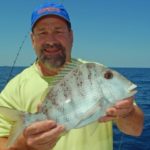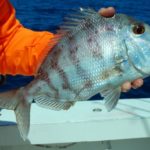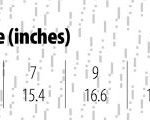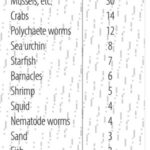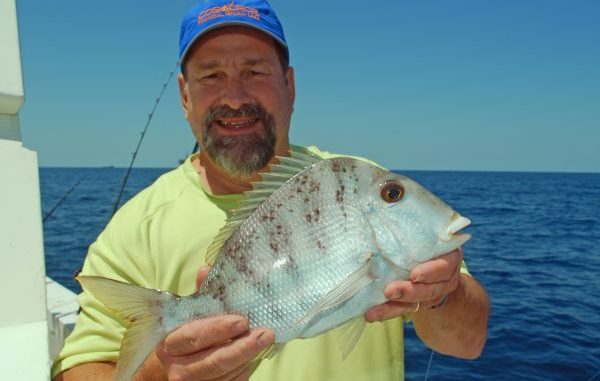
The knobbed porgy, an offshore species in the Gulf of Mexico, is named for the bony bumps located just in front of its eyes.
But they aren’t this fish’s most-notable feature. That would be its ridiculously steep and sloping forehead. Its profile gives the fish an almost comical appearance.
If the head shape isn’t enough to identify it, a couple of color features are helpful. Its purplish head with many yellow-bronze spots are an identifier, as are the bright-blue blotches at the base of each pectoral fin.
In freshly caught fish, the body is marked by six broad but indistinct vertical bands. These, however, always fade to invisibility once the fish is iced.
Knobbed porgies belong to a family that is both familiar and unfamiliar to Louisiana saltwater fishermen. Twelve members of the porgy family can be found in the northern Gulf of Mexico, but most Louisiana fisherman can name only two — the sheepshead and the pinfish. Both are inshore species. Most of the rest of the family lives offshore.
Our hero carries the scientific name of Calamus nodosus. Calamus comes from the Greek “kalamos,” which means cane or reed. How it became part of the name is a mystery.
The species name nodosus is Latin and refers to the nodes or knobs located in front of the fish’s eyes.
In some parts of its range it is locally called Key West Porgy. Off Louisiana, the only name ever applied to the fish (along with the whitebone and jolthead porgies) is “white snapper.”
Most bottom fishermen in the northern Gulf don’t call them anything at all — they either toss them back or cut them up for bait, which is really a shame.
Knobbed porgies are very good table fish, with flesh as white as snappers’ but moister.
Knobbed porgies are found from North Carolina through the Gulf of Mexico and farther south to Belize. They are very common in the waters of the Florida Keys, the Bahamas, Cuba, Haiti, Santo Domingo and Puerto Rico.
They are listed as least common off the Louisiana and Mississippi coasts, but that might be more of a reflection on the depth at which their populations occur than actual numbers of the fish themselves.
In the clear waters that host reef habitat in much of their range, they can be found in waters as shallow as 25 feet. Louisiana’s nearshore waters are turbid and heavily influenced by Mississippi River discharges; here the fish is found more in the deeper (and less accessible to fishermen) part of its range — 150 to 300 feet deep.
They are most at home on hard bottoms, rocky ledges and reef-type habitats (which are deeper off Louisiana than other places), and nearby areas of sand, gravel or grass.
Off Louisiana, they are especially numerous on the crests of shelf-edge banks that rise out of deep water like small mountains.
Twelve of these large, rocky banks occur, from Sackett Bank (aka the Midnight Lump) in the east to the West Flower Garden in the west.
Knobbed porgy have powerful jaws, large incisors and strong molars, as well as heavy teeth in their throats called pharyngeal teeth that are used to crush the hard-shelled foods in their diet.
Food studies indicate knobbed porgies prefer to eat more smaller food items rather than fewer, larger items.
The chart shows how few fish are found in their stomachs, an indicator that cut fish is not the best choice of baits.
Knobbed porgies are one of the slowest-growing of reef fishes. Growth is fastest the first 4 to 5 years of life, averaging 3.3 inches per year. Then it slows dramatically: From 6 to 10 years old, it averages only a half-inch per year. After age 10, their growth rate slows even more.
Knobbed porgies reach sexual maturity at 4 to 5 years of age. All begin lives as females. Between 12 and 20 inches long, they change to males — at least most of them do.
In one study, females made up 88 percent of all the fish under 17.3 inches long, while males made up 72 percent of all fish over that length.
In that study, two fish bucked the trend. One male was found less than 11 inches long and one female was over 21 inches long. This indicates that not all knobbed porgies change sex.
Research on a closely related species, the whitebone porgy, showed that only 60 percent of that species change sex.
Spawning off of the Carolinas, where the fish is an important recreational and commercial species, extends from February through July. Peak spawning is in April and May.
